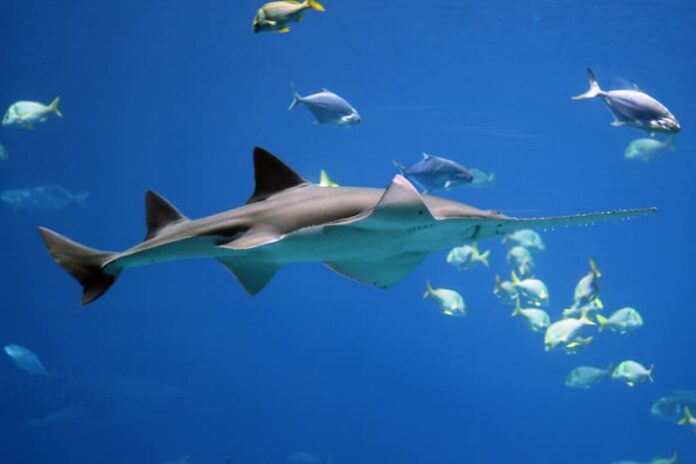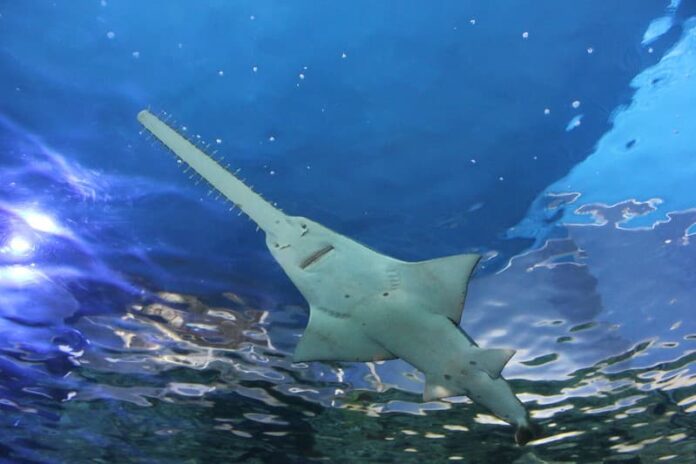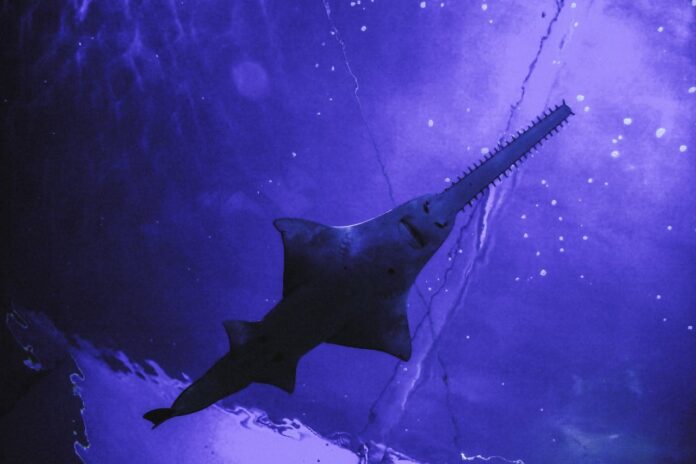Sawfish or carpenter sharks are neither fish nor sharks because they actually belong to the ray family instead. A sawfish is characterized by a long, narrow, and flattened nose extension known as a rostrum lined with sharp transverse teeth. This unique fish species is found worldwide in subtropical and tropical regions in brackish estuarine and coastal marine waters. Today, there are only 5 living sawfish species and all of them are already endangered due to human actions. I am writing about sawfish now just to let you know about each of them before they are gone.
1Dwarf Sawfish

Reaching just over 3 meters in length, dwarf sawfish is the smallest of all sawfish species in the ocean. The range of this sawfish species is very small, only in the Indo-Pacific Ocean, mostly in tropical northern Australia. Its habits include estuaries and shallow inshore areas like mangrove swamps and tidal flats within a few kilometers of the coast. Where they live, the dwarf sawfish use their saws to find, stun, and kill prey such as small schools of fish. Sometimes they also feed on crustaceans and mollusks that they can find. The population of this fish has been in decline due to bycatch, entanglement, and habitat loss. Although it is illegal to catch dwarf sawfish in Australian waters, they are susceptible to being caught in gillnets and trawl nets. At the same time, bycatch remains the biggest threat to this species throughout their range.
2Green Sawfish

Green sawfish or longcomb sawfish is a large sawfish species that is native to tropical and subtropical waters. This fish species has a broad distribution in Indo-West Pacific, ranging from Southern Africa and Southern China to Southeast Asia and Australia. Throughout those ranges, this large sawfish lives in shallow coastal waters but sometimes they go as deep as 70 meters. Just like their other brothers, green sawfish feed primarily on fish as well as prawns if they catch any. All sawfish are harmless to humans, even with a large species like this one. The only time they could injure a person is when they defend themselves with their saw when captured.
With a length of up to 7.3 meters, the green sawfish is the largest of all existing sawfish today. The interesting part is that its teethed rostra account for almost one-third of the entire length of the fish. Those teeth are unevenly spaced along the rostrum, and there are between 24 to 37 pairs of teeth on average. Because of the long nose, fishing is the main threat to their population because bycatch and entanglement are very common. Besides fishing, habitat loss is another threat to their population which plays a part in the decrease of their number. This species is now critically endangered, but there have been laws in some areas to protect green sawfish.
3Largetooth Sawfish

The most prominent feature of the largetooth sawfish is their rostrum, with 14 to 23 large rostral from which teeth are protruding. This rostrum comprises almost a quarter of the total length of this sawfish species which is around 6 meters or longer. When hunting, a largetooth sawfish moves its rostrum back and forth like a saw to stun and kill the prey. This rostrum is also a weapon for this sawfish to protect itself from its natural predators like saltwater crocodiles and sharks. The range of this sawfish species is from the Gulf of Mexico to the Atlantic Coast of Central and South America. Largetooth sawfish can tolerate a range of salinities so they are very flexible with their habitats. This fish species live in both freshwater and saltwater since they also travel far up river systems sometimes.
While some other times, especially during the dry season, they venture into bays and coastal marine habitats. This species tends to live in rivers when they are young before they move to the sea when they mature. In the areas they live, this sawfish species feed on prawns and other crustaceans as well as fish. Sadly, largetooth species is the most endangered sawfish and they are at serious risk of becoming extinct. Bycatch and entanglement are the main threats that these sawfish have been facing until now. Fishermen also target them for their skin to use in luxury fashion along with medicine, shark-fin soup, and weaponry. Apart from these, climate change and habitat loss also play an important part in shrinking their population. This is why their number has drastically dropped in the past few decades which makes them a critically endangered species.
4Narrow Sawfish

Also known as the knifetooth sawfish or pointed sawfish, narrow sawfish is one of the members of the sawfish family. This sawfish species live in estuaries and shallow coastal waters of the Indo-West Pacific, ranging from the Red Sea to Australia. They live and hunt near the bottom of the sea floor, mid-water, and near the surface at depths of 100 meters. Slightly bigger than the dwarf sawfish, narrow sawfish can reach a length of 3.5 meters. This sawfish species has a shark-like body, but it has a flat head which is different from other sawfish. The head of this sawfish extends forward like a blade, and its teeth are short and flat in a triangular shape.
Similar to the largetooth sawfish, narrow sawfish can also tolerate a wide range of salt levels. That means they also move between estuarine and marine environments within ranges, switching habitats without a problem. The diet of this sawfish species is wider because it includes invertebrates, small fish, and squids. Despite the size, narrow sawfish are very docile and harmless to humans. When highly stressed, a narrow sawfish will flail its head from side to side to defend itself. Just like any living beings, this fish will move around when caught in a net which can inflict serious injuries. With that being said, commercial fishing is the biggest threat to their population for the last few decades. This species is now also endangered, resulting from other factors such as habitat loss and overutilization.
5Smalltooth Sawfish

In spite of the name, smalltooth sawfish is not too small since its length can reach up to 5.4 meters. The fascinating thing about them is that they use their long rostrums for 2 purposes: locating prey and immobilizing it. A smalltooth sawfish’s rostrum is covered with special organs that help them to locate prey even in low visibility. Once it detects the prey, it shakes its head from side to side which either injures or stuns the fish. Sometimes it also uses its rostrum to dig for buried invertebrates in soft sediments on the sea floor. The habitats of smalltooth sawfish are coastal seas and estuaries, and they rely heavily on mangrove forests during their juvenile years.
Due to the population decline, there have been protection measures to achieve the recovery of the smalltooth sawfish. The good thing is that there are no longer any legal targeted fisheries for this sawfish species. However, bycatch and entanglement are still common because of their rostrums. At the same time, poaching still occurs for shark-fin trade even if there is legal protection for this species. Another reason that still threatens their population is the loss of mangrove forests that are their nursery areas. With all of the reasons above together, smalltooth sawfish is now critically endangered which is very vulnerable to extinction.
Related Post: Hammerhead Shark Species




